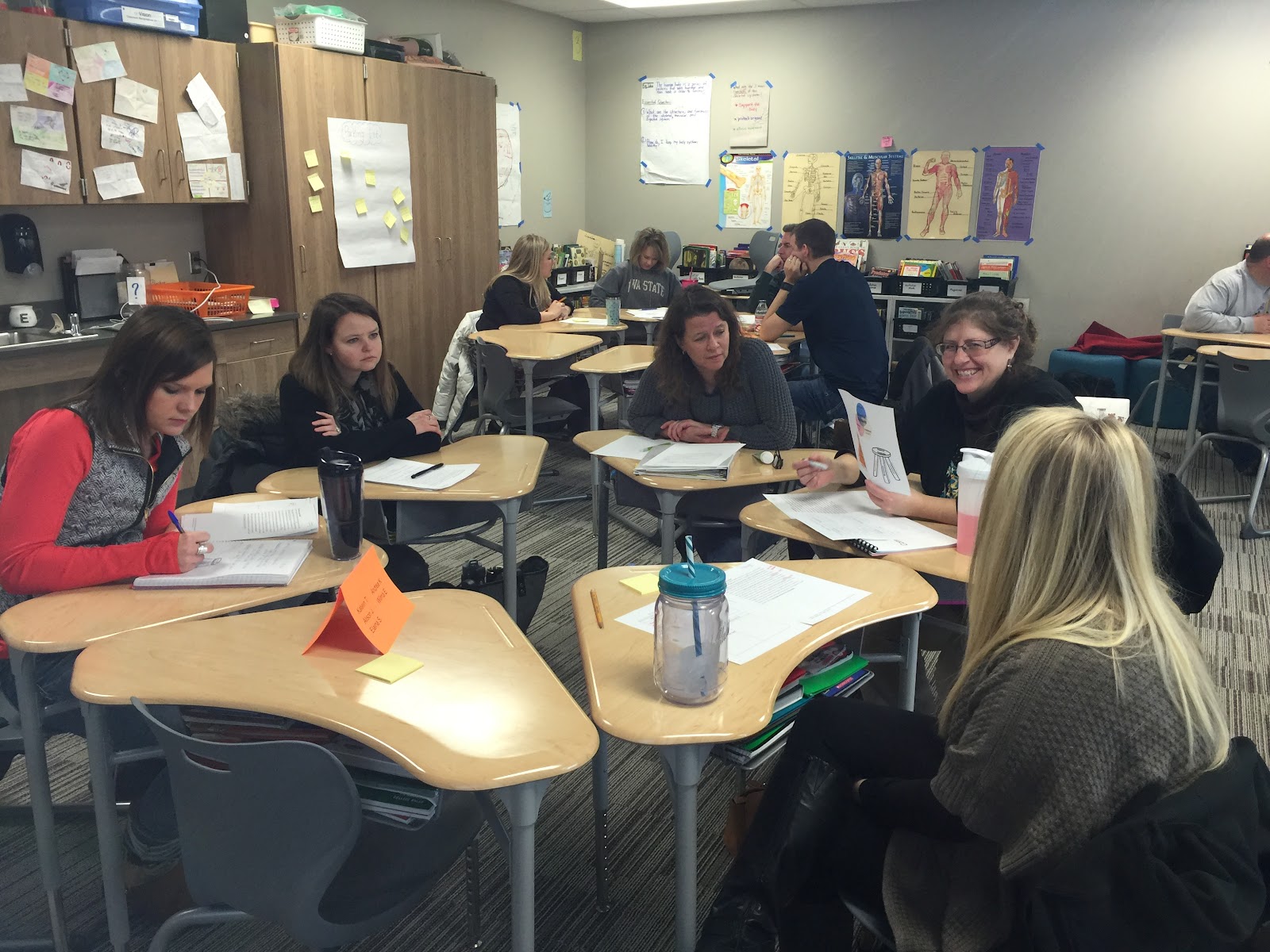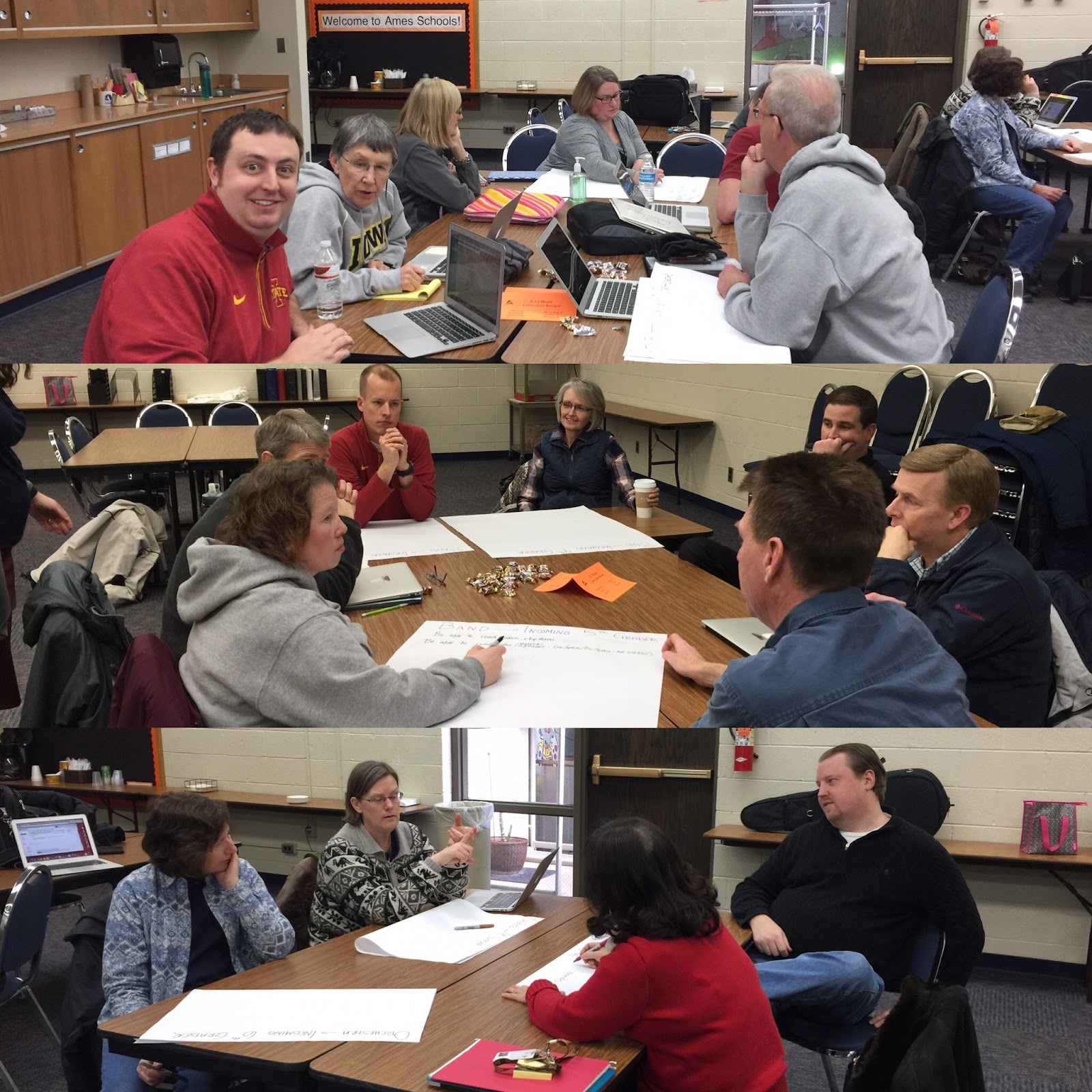Inquiring minds want to know what really happens on a full day of professional learning across the District. Monday, January 18 was chocked full of differentiated professional learning for all educators in the Ames Community School District. Here’s a little insight as to what happened with several of the different groups.
Northwood
Our day of learning at Northwood was spent expanding our understanding of the components of a Quality Early Childhood Literacy program. Principal, Brandon Schrauth, began the day by modeling the different Intentional Teaching Structures for Early Literacy in Reading, Writing and Oral Language. Mentor teacher, Kendra Wuestenberg, spoke on the topic of Phonological Awareness and how to increase our understanding and teaching of the vast array of skills that encompass it. Model teacher, Nichole McCrady, taught us about Alphabetic Principle and different ways to infuse alphabet work into our half-day programs. Instructional Coach, Johanna Hicks, lead a discussion around comprehension and how we can teach our students how to think within, about and beyond text that is read to them. Model teacher, Alicia Ortner, finished each presentation by fostering conversations about we can engage ALL learners by embedding these strategies into our regular classroom activities. Each presenter ended their discussions with a make and take time for teachers to use the knowledge they learned to prepare items for use in their classroom.
Make and Take time! Alicia Ortner explaining Nichole McCrady explaining
modifications for the classroom Alphabetic Principle
Elementary
Calibrating understanding of how endurance, leverage and readiness play into determining what standards are most essential to teach until mastery for our students was the hot topic of the morning for all K-5 teachers. The Teachers on Special Assignment for the District led the different grade levels and started the discussion by sharing the history of Essential Standard work in the past and the vision for this work in the future. Grade level teams reflected on data around the number of reading and math essential standards currently chosen as well as whether or not we had alignment in which standards are being taught in the classrooms.


A portion of text from Common Formative Assessments by Kim Bailey and Chris Jakicic was used to ground us in what the experts say on this topic. Following that learning, teams of teachers practiced using a rubric to force rank selected reading and math CCSS standards by looking at the amounts of endurance, leverage, and readiness they have. The morning ended with PLCs using their new learning and common language to re-examine their essential standards. This work will be instrumental in moving us down the road towards creating District Level Essential Standards.
Middle School
Our professional learning opportunities for middle school staff began with a Rare Birds activity to kick off a morning of collegiality and learning. Staff learning in the areas of digital citizenship, common formative assessment, rubric creation, and analyzing data followed. One of the highlights of the morning was the opportunity to watch and reflect on John Hattie’s Ted Talk, Why are So Many of our Teachers and Schools so Successful?.
This video provided staff with insight as to why when we work together in a collective effort, our students respond with greater academic success and growth. We continued our learning with a refresher on the PLC flow chart and broke out into one of three differentiated sessions:
Creating a focused and reasonable, common formative assessment
Creating a quality rubric to describe proficient student work
Analyzing and responding to common formative assessment data
PLC’s came together in the afternoon to share their takeaways from the morning, and continue down the path of collaborative work. There are some truly great things happening at Ames Middle School. The staff is passionate about the work they are doing. The continued development and growth of PLC’s at Ames Middle School is evident in the conversations amongst teaching staff. It is an exciting time at AMS!
High School
Professional development has focused on core area teachers planning a mental model to share with their students of how they construct meaning “when the text is difficult and the task matters.” The learning outcome for this mental model was for students to observe their teacher constructing meaning from a passage of which they had little to no background knowledge.
While all teachers engage in explaining, analyzing, and/or interpreting complex text for students, we acknowledge that we do not always show students how we think about the text to reach these explanations, analyses, and/or interpretations. Through observing an expert reader in their particular subject area, students should be able to “see” the invisible process of creating meaning from complex text.
Prior to Monday, model teachers Ginny Seibert, Leah Stearns, Instructional Coach Katie Gustafson, and Ben Matthies provided a model for teachers in their respective departments of what a mental model looked and sounded like. On Monday, teachers worked in large, departmental groups to discuss necessary background information about modeling for students; individual teachers then set up times to meet one-on-one with the Instructional Coaches to work collaboratively in constructing a thorough mental model. These mental models were then presented to students in their core classes on the Tuesday and Wednesday prior to the start of the Iowa Assessment tests.
Speciality Areas
Music
 Music educators in Ames gathered as a K-12 team in order to strengthen their common vision for music education in Ames. After spending time outlining the skills students need in order to be successful in band, orchestra, general music and choir, teachers worked together to outline the benchmarks at for elementary, middle and high school students. Moving forward, teachers will be revising their grade and course level expectations, revising assessments, and exploring new materials to use with student musicians. These teachers’ passion and dedication to serving students is truly inspiring.
Music educators in Ames gathered as a K-12 team in order to strengthen their common vision for music education in Ames. After spending time outlining the skills students need in order to be successful in band, orchestra, general music and choir, teachers worked together to outline the benchmarks at for elementary, middle and high school students. Moving forward, teachers will be revising their grade and course level expectations, revising assessments, and exploring new materials to use with student musicians. These teachers’ passion and dedication to serving students is truly inspiring.
Family and Consumer Sciences
The Ames Middle School and Ames High School teachers of family and consumer sciences met together to share some learning and strengthen the alignment of their programs. They spent time reading the Financial Literacy Work Team Report from 2014 and studying the 21st Century Skills for Financial Literacy. They shared essential standards and activities for teaching financial literacy. They are passionate about educating all students in the Ames Community Schools in the financial skills necessary for living and working in the 21st Century.
Art
Submitted by Susan “Coach” Norris
Art teachers met as a K-12 PLC and were lead by TOSA Mary Morton. Mary divided us into groups with elementary, middle school and high school teachers in each group. We began group work by sharing one portfolio item and process with each other. High school art teacher Lindsay Wede shared examples of photo essays created by Photography 1 students followed by Sara Knutson sharing watercolor landscape works by 6th graders. Laurie Olk presented examples of self-portraits created by K-5. I shared a Powerpoint created for grades 3-5 to introduce a TAB (Teaching Artistic Behaviors) concept. Mary then presented a rubric to help compare the Iowa Core Companion document and the National Core Arts Standards with our current course level expectations for elementary, middle school and high school levels of learning. We considered the purpose, level of alignment to best practice, as well as positives and negatives for each document. Working on and discussing the rubric allowed the K-12 art PLC to formulate a recommendation we can share with the School Board regarding ongoing work with curriculum. Each level has scheduled work days over the next three months to formulate Curriculum Review Action Plans.
PE
Physical Education teachers met for the second time on Monday to continue to align their work with students to a K-12 vision. The discussion began with a review of the essential components of physical education, policy / environment, curriculum, instruction, and assessment. Studying the National Standards for Physical Education collaboratively in mixed and PLC teams fostered great conversations that ranged from assessment and grading practices to student behaviors. Always an enthusiastic group, the PE teachers showed dedication, passion, and commitment to their students and each other. These teachers are now in the process of creating PLC level action plans to channel that work for Ames students.




